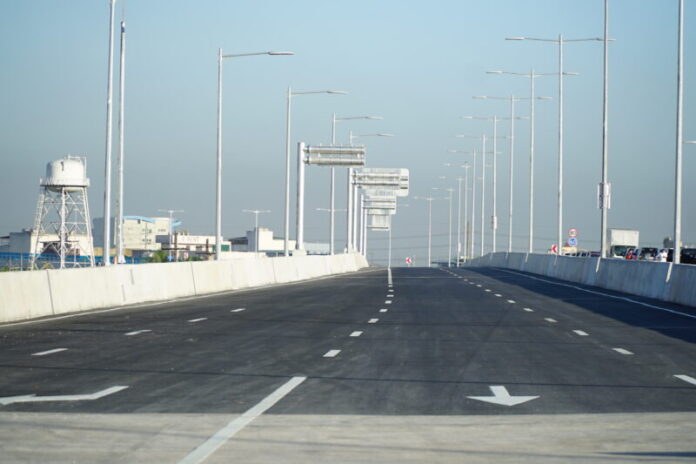
-
The first section of the NLEX Connector road project between Caloocan and España interchanges was inaugurated on March 27
-
The first 5.15-kilometer section of the four-lane NLEX Connector extends from the end of North Luzon Expressway (NLEX) Segment 10 in C3 Road, Caloocan City to the España Interchange along España Boulevard in Manila City
-
The entire NLEX Connector, seen to decongest major thoroughfares in the metro, stretches eight kilometers starting from Caloocan Interchange on C3 Road up to the vicinity of the Polytechnic University of the Philippines in Sta. Mesa, Manila
-
When completed, the P23.2 billion road project is seen to greatly reduce travel time from South Luzon Expressway-Alabang to NLEX-Balintawak from two hours to just 20 minutes
The first section of the NLEX Connector road project between Caloocan and España interchanges was officially inaugurated on March 27 by President Ferdinand Marcos, Jr.
The first 5.15-kilometer section of the four-lane NLEX Connector extends from the end of North Luzon Expressway (NLEX) Segment 10 in C3 Road, Caloocan City to the España Interchange along España Boulevard in Manila City. It is expected to reduce traffic congestion in España Boulevard, Abad Santos Avenue, Rizal Avenue and Lacson Avenue by diverting trucks and other vehicles from major roads.
During the inauguration, Marcos said his administration will continue developing a highly interconnected road network that will facilitate the country’s inclusive and sustained economic growth.
He also called on the Department of Transportation and NLEX Corp., project developer and toll operator of NLEX and NLEX Connector, to work closely with their partners in accomplishing the government’s objectives in improving the country’s road infrastructure.

“Try very hard, as we all do, to stay within the target time frame – although your success rate in this regard is exemplary – avoid unnecessary delays, and finish the project as scheduled, so that the Filipino people will be able to reap the benefits as soon as possible,” the President pointed out.
“Ultimately, the positive effects of this project will speed up mobility and transactions, and will spur economic productivity of the country,” he noted.
He called the NLEX Connector project “another achievement and undoubtedly will significantly improve the mobility of people, of goods, and of services not only within Metro Manila but also within its environs.”
Under the “Build, Better, More” development agenda of the Marcos administration, the President vowed to continue pushing for the interconnectivity of major roads and expressways, as well as build even more roads and bridges in strategic places within the archipelago.
For his part, NLEX Corp. president and general manager J. Luigi Bautista said: “The NLEX Connector reinforces the primary objective of infrastructure development which is to improve the lives of people. It also promotes efficient movement of goods and essential logistics providing 24/7 access to our truckers who are a vital link to our supply chain.”
The entire NLEX Connector stretches eight kilometers starting from Caloocan Interchange on C3 Road up to the vicinity of the Polytechnic University of the Philippines in Sta. Mesa, Manila.
When completed, the P23.2-billion road project is seen to greatly reduce travel time from South Luzon Expressway (SLEX)-Alabang to NLEX-Balintawak from two hours to just 20 minutes, and between Clark in Pampanga and Calamba, Laguna to 1 hour and 40 minutes from three hours.
It will also contribute to the ease of movement of cargo and goods from north to south and vice versa, especially those coming from the Port of Manila, providing great relief to the logistics sector being an alternative route for truckers.
The project is estimated to benefit at least 35,000 vehicles per day and projected to improve connectivity between airports and seaports.
Construction of the second section stretching from España Boulevard to PUP, meanwhile, is being fast-tracked to provide trucks with an alternative route from the ports to the south and improve connectivity between Ninoy Aquino International Airport and Clark International Airport, the Department of Public Works and Highways earlier said.
As of March 23, Section 2 was 42% done and is targeted for completion by June 2023, provided the right-of-way for the section is delivered to the contractor by end of March.
Designed to cater to all vehicle classes including trucks, NLEX Connector intends to spur economic progress by significantly improving the travel of motorists especially those in the logistics sector as the new road will shorten the travel time of cargoes.
NLEX Connector is a joint effort by NLEX Corp., Metro Pacific Tollways Corp., Department of Transportation, Department of Public Works and Highways, and Toll Regulatory Board.
Apart from Marcos and Bautista, the inauguration rites were attended by Finance Secretary Benjamin Diokno, Public Works and Highways Secretary Manuel Bonoan, Transportation Secretary Jaime Bautista, and Metro Pacific Investments Corporation Chairman Manuel V. Pangilinan.
RELATED READ: Three major NLEX projects in the pipeline




